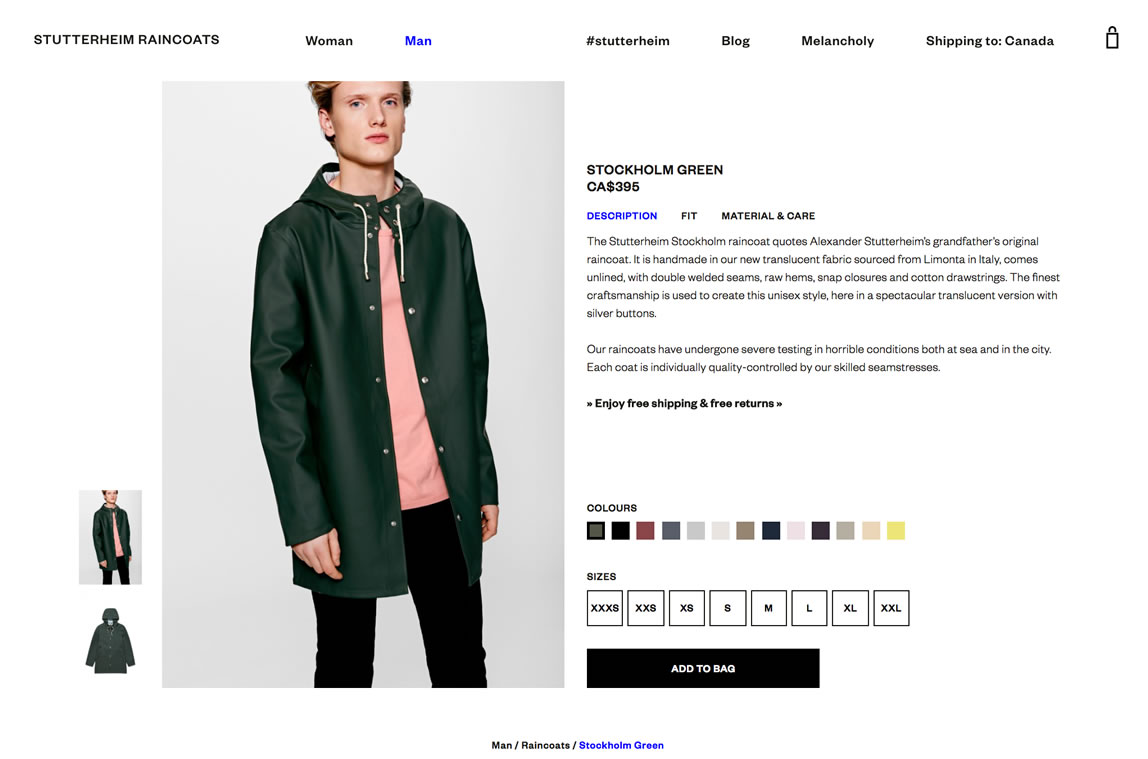What type of content do super successful sites create for each level of search intent? It’s not what you’d expect.
In our whitepaper, Using search intent to connect with consumers, we looked at how SERP features change with a searcher’s intent — informational, commercial, transactional, or local.
But while doing the research, we found ourselves pondering another question: is there a similar relationship between search intent and the kind of page content that Google sources results from?
We know from our study that as searchers head down the intent funnel, the SERP feature landscape shifts accordingly. For example, Google serves up progressively more shopping boxes, which help close the deal, as a searcher moves from awareness to purchase.
So, as consumers hunt for that perfect product, does the content that Google serves up shift from, say, category pages to product pages? To get to the bottom of this mystery, we mounted a three-pronged attack.
We mounted a three-pronged attack
Setting our sights on what type of content is served up at each stage of intent.
Prong 1: Uncover the top SERP players
Since Google delivers the content they deem most helpful, figuring out who their SERP favs are ensured that we were analysing the best performing content.
To do this, we used the same 6,422 retail keywords from our original research, segmented them by search intent, and then gathered the top 12 results (give or take a few) that appeared on each SERP.
This gave us:
- 6,338 informational intent results,
- 35,210 commercial intent results,
- 24,633 transactional intent results,
- and 10,573 local intent results
…to analyse the stink out of. (That’s 76,754 results all told.)
From there, we dug into root domains (e.g. eBay.com and Amazon.com) to uncover the four most frequently occurring businesses for each search intent category.
We made an executive decision to exclude Google, who claimed top billing across the board, from our analysis for two reasons. One, because we attribute shopping boxes and images to them, which show up a lot for retail keywords, and two, because they aren’t exactly a competitor you can learn from.
Swipe for more →
| Search intent | 1st place (results) | 2nd place | 3rd place | 4th place |
| Informational | Amazon (573) | Walmart (250) | Wikipedia (231) | Best Buy (157) |
| Commercial | Amazon (3,203) | eBay (1,068) | Walmart (772) | Best Buy (627) |
| Transactional | Amazon (2,371) | Walmart (1,170) | eBay (885) | Best Buy (616) |
| Local | Walmart (371) | Amazon (336) | Yelp (314) | Best Buy (209) |
The top SERP players
Best-performing sites by search intent.
Prong 2: Identify content page markers
After compiling the winningest sites to snoop on, it was time to see what kind of content they were offering up to the Google gods — which should’ve been easy, right? Wrong. Unfortunately, examining URL structures for frequently occurring page markers is a somewhat painful process.
Some sites, like Homedepot.com (who we wish had made the list for this very reason), have clean, easy to decipher URL structures: all product and category pages are identified with a “/p/” and “/b/” that always show up in the same spot in the URL.
And then you have the Amazon.coms of the world that use a mix of seemingly random markers, like “/s?rh=” and “/dp” that appear all over the place.
Identifying page markers isn't the easiest
But we prevailed!
In the end — thanks to Stack Overflow, SequelPro, and a lot of patience — we were able to classify our URLs, bringing us to our third and final prong.
Prong 3: Mash everything together and analyse
Once we got all of our ducks in a row, it was time get our super-sleuth on.
Informational intent (6,338 results)
This is the very top of the intent funnel. The searcher has identified a need and is looking for information on the best solution — is a [laptop] or [desktop computer] the right choice for their home office; what’s the difference between a [blender] and a [food processor] when making smoothies?
Swipe for more →
| Top sites | Category page (% of total results) |
Product page | Review | Buyer guide |
| Amazon | 473 (7.5%) | 100 (1.6%) | 0 | 0 |
| Walmart | 208 (3.3%) | 42 (0.7%) | 0 | 0 |
| Wikipedia | 0 | 231 (3.6%) | 0 | 0 |
| Best Buy | 96 (1.5%) | 61 (1.0%) | 0 | 0 |
The top sites for informational queries
These sites appeared most often and served up a mix of category and product pages.
Thanks to the retail nature of our keywords, three product powerhouses — Amazon, Walmart, and Best Buy — rose to the top, along with Wikipedia, whose sole purpose in life is to provide the kind of information that searchers usually want to see at this stage of intent.
Although Wikipedia doesn’t have page markers, we chose to categorize their search results as product pages. This is because each Wikipedia entry typically focuses on a single person, place, or thing. Also, because they weren’t important to our analysis: while Wikipedia is a search competitor, they’re not a product competitor. (We still love you though, Wikipedia!)
We don't count Wikipedia in this retail race
Their sole purpose is to provide information to those who seek it. They’re not a product competitor.
Diving into the type of content that Amazon, Walmart, and Best Buy served up (the stuff we were really after), category pages surfaced as the preferred choice.
Given the wide net that a searcher is casting with their informational query, it made sense to see more category pages at this stage — they help searchers narrow down their hunt by providing a wide range of options to choose from.
What did have us raising our eyebrows a little was the number of product pages that appeared. Product pages showcase one specific item and are typically optimized for conversion, so we expected to see these in large quantities further down the funnel — when a searcher has a better idea of what they want.
Commercial intent (35,210 results)
When it comes to a commercial intent query, the searcher is starting to dig deeper into the product they’re after — they’re doing comparative research, reading reviews, and looking into specific functionality.
Swipe for more →
| Top sites | Category page | Product page | Review | Buyer guide |
| Amazon | 2,497 (7.1%) | 600 (1.7%) | 103 (0.3%) | 3 (0.009%) |
| eBay | 934 (2.7%) | 41 (0.11%) | 0 | 93 (0.3%) |
| Walmart | 583 (1.7%) | 189 (0.5%) | 0 | 0 |
| Best Buy | 359 (1.0%) | 264 (0.7%) | 0 | 4 (0.01%) |
The top sites for commercial queries
These sites appeared most often and served up a few more product pages, some reviews and buyer guides, and another mother lode of category pages.
Here, Amazon continued to rule the URL roost, Wikipedia dropped off, eBay judo-chopped Walmart out of second place, and Best Buy stayed put at the bottom.
Walmart takes a backseat to eBay
When it comes to our commercial queries, eBay snags more results.
In terms of the content that these sites offered up, we saw the addition of review pages from Amazon, and buyer guides from Amazon, eBay, and Best Buy. We figured this would be the case, seeing as how we used modifiers like “best,” “compare,” and “reviews” to apply commercial intent to our keywords.
But while these two types of content fit perfectly with the intent behind a commercial query, especially reviews, oddly enough they still paled in comparison to the number of category and product pages. Weird, right?
Transactional intent (24,633 results)
At the transactional intent stage of the game, the searcher has narrowed their hunt down to a few best options and is ready to throw their hard-earned shekels at the winner.
Swipe for more →
| Top sites | Category page | Product page | Review | Buyer guide |
| Amazon | 1,650 (6.7%) | 716 (2.9%) | 1 (0.0004%) | 4 (0.02%) |
| Walmart | 1,008 (4.1%) | 162 (0.7%) | 0 | 0 |
| eBay | 797 (3.2%) | 53 (0.2%) | 0 | 35 (0.1%) |
| Best Buy | 354 (1.4%) | 258 (1.0%) | 0 | 4 (0.02%) |
The top sites for transactional queries
We saw lots of product pages, but nowhere near as many as we had imagined. And holy cow! Look at all those category pages.
As far as the most frequently appearing sites go, there was a little do-si-do between eBay and Walmart, but overall, these top four sites did an excellent job following searchers down the intent funnel.
In terms of the kind of pages appearing, once again, we saw a huge number of category pages. Product pages made a respectable showing, but given the readiness to buy at the bottom of the funnel, we expected to see the scales tip in their favour.
Alack and alas, no dice.
Local intent (10,573 results)
Technically, we categorize local intent as a subsection of transactional intent. It’s likely that the only reason a searcher would be considering an in-store visit is if the product is something they want to take home with them. But because local searches typically surface different results from our other transactional queries, we look at them separately.
Swipe for more →
| Top sites | Category page | Product page | Review | Buyer guide |
| Walmart | 298 (2.8%) | 73 (0.7%) | 0 | 0 |
| Amazon | 181 (1.7%) | 151 (1.4%) | 2 (0.02%) | 2 (0.02%) |
| Yelp | 235 (2.2%) | 77 (0.7%) | 2 (0.02%) | 0 |
| Best Buy | 118 (1.1%) | 91 (0.9%) | 0 | 0 |
The top sites for local queries
We welcome Yelp to the party and say “see ya later” to eBay.
Here, Amazon’s reign was finally usurped by its biggest competitor, Walmart, and Yelp made a stunning first appearance to knock Best Buy down and eBay off the list.
Walmart kicks Amazon out of the top spot
After three consecutive wins, Amazon is pushed down into second place when it comes to local queries.
Given that local intent searchers are on the hunt for a brick-and-mortar store, it made sense that Walmart would win out over Amazon. That said, it’s an incredible feat that Amazon doesn’t let a lack of physical location derail its retail dominance, espcially when locale is the name of the game (a location is literally part of these queries).
As for Yelp, they’re a trusted source for people trying to find a business IRL — so it wasn’t surprising to see them jump on our local intent SERPs. Like Wikipedia, Yelp doesn’t have product or category pages per se, but they do have markers that indicate pages with multiple business listings (we classified these as category pages), as well as markers that indicate single business listings (our product pages). We also found markers for reviews, which were a perfect fit for our analysis.
Finally, when it came to content, category and product pages (again!) showed up the most on these SERPs. So what’s going on here?
The (unexpected) takeaway
When we set out to examine the type of content that appears for the different search intents, we expected to see far more variation from one level to the next. We thought we’d find lots of category pages for informational intent, more reviews and buyer guides for commercial intent, and mostly product pages for transactional intent.
Instead, we found that category pages are Google’s top choice for retail keywords throughout all levels of search intent. Regardless of how specific a query is, category pages seem to be the first point of access when hunting for retail items. So why might this be?
Looking to our winning sites for answers, it appears that intent-blended pages are the bomb dot com for Amazon, Walmart, eBay, and Best Buy.
Their category pages contain: an image of each type of product and short, descriptive copy to help searchers narrow down their options (informational intent); a review or rating system for quick comparisons (commercial intent); and pricing information and a clear way to make a purchase (transactional intent).
Our big four sites like intent-blended pages
Best Buy piles all the things on their category pages, like reviews, similar products, and “more to explore.”
Following any of the items to their designated product page — the second most returned type of content — you’ll find a similar intent-blended approach. In fact, by having alternative suggestions, like “people also bought” and “similar products,” appear on them, they almost resemble category pages.
This product page approach is different from what we often see with smaller boutique-style shops. Take Stutterheim for example (they sell raincoats perfect for our Vancouver weather). Their product pages have a single focus: buy this one thing.
Since smaller shops don’t have a never-ending supply of goods, their product pages have to push harder for the transaction — no distractions allowed. Large retailers like Amazon? They have enough stuff to keep searchers around until they stumble across something they like.
A smaller retailer's product page
Sites like Stutterheim tend to have a single-product page with a single CTA.
To find out what type of content you should serve at each step of the intent funnel, segment your keywords by search intent and track which of your pages rank, as well as how well they convert. This will help reveal what your searchers find most useful.
And if you’re itching to do your own content analysis, we’d love to show you how with a personalized demo.
Read on, readers!
More in our search intent series:
- How SERP features respond to intent modifiers
- A guide to setting up your very own search intent projects
- The basics of building an intent-based keyword list









